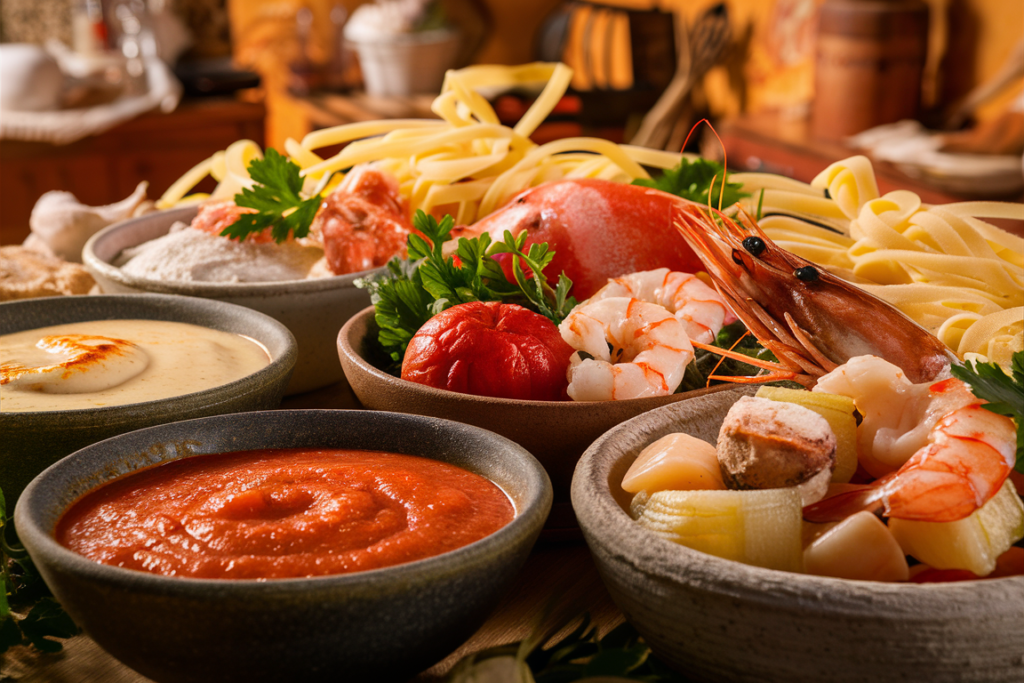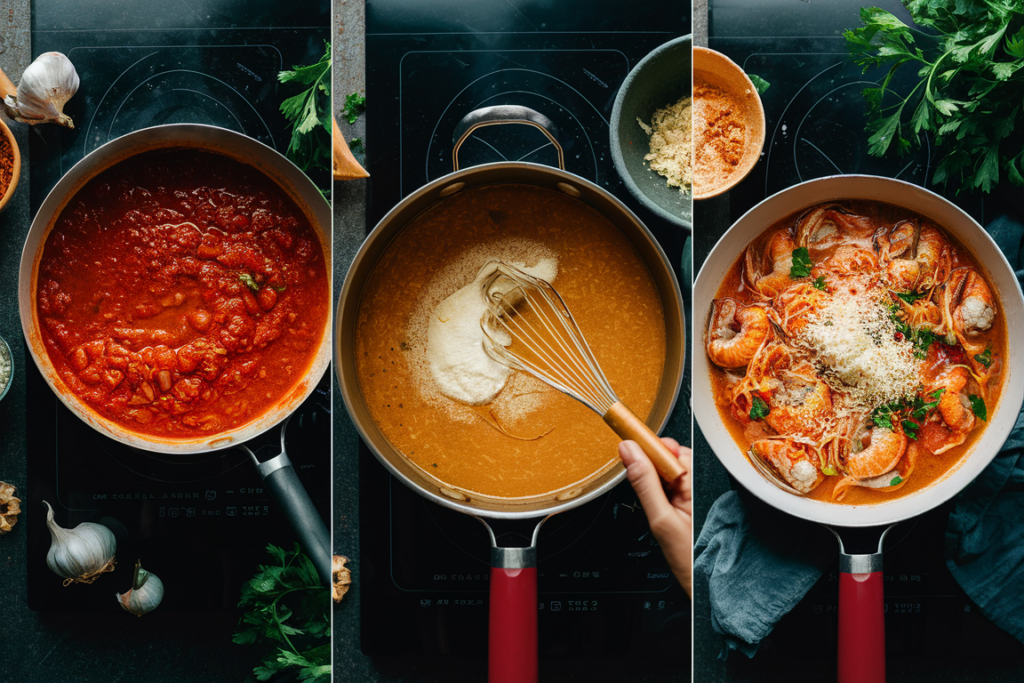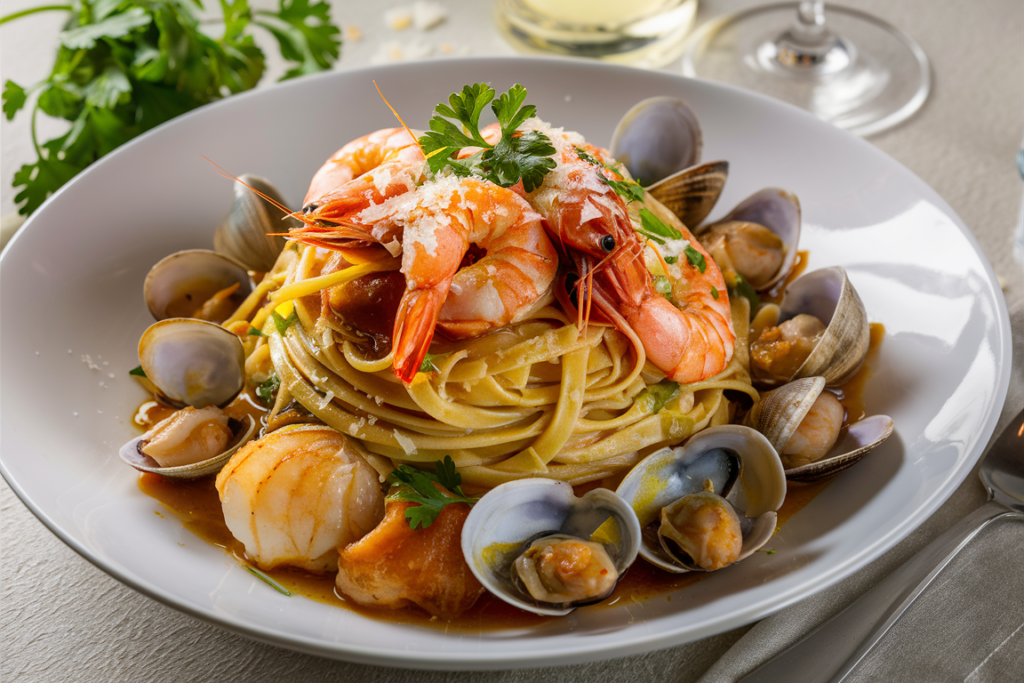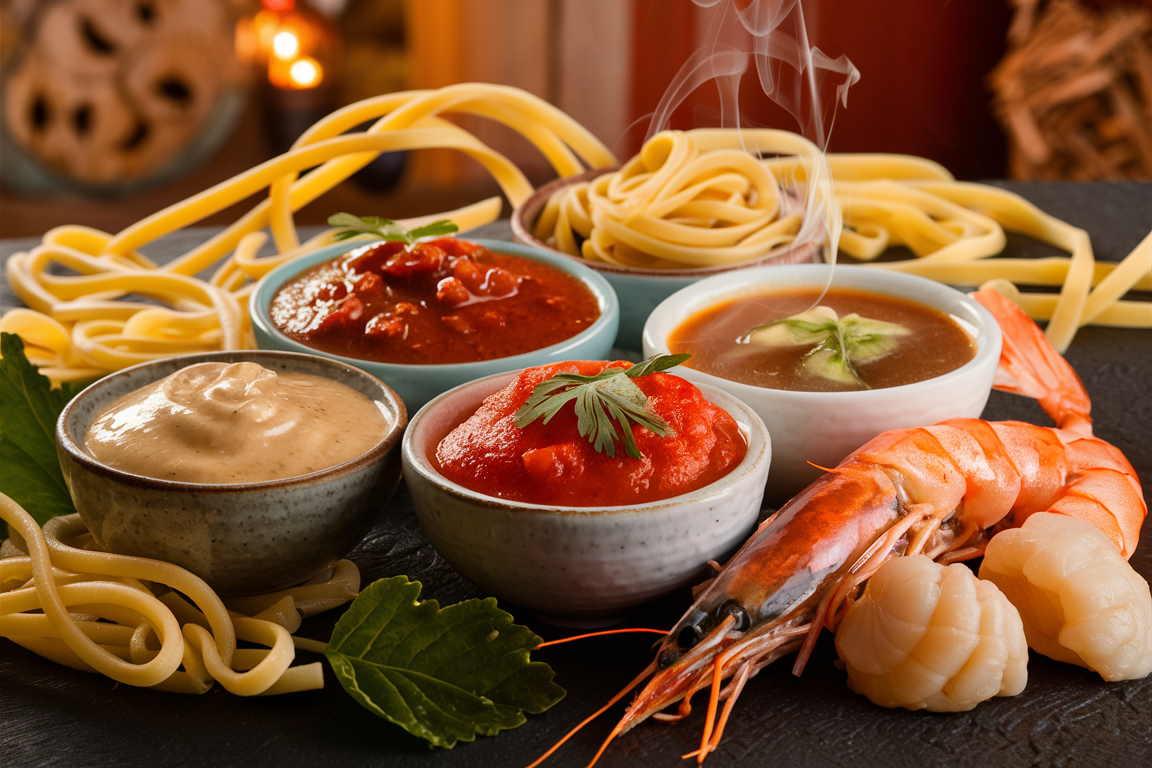How to Thicken Seafood Pasta Sauce
Seafood pasta dishes are a luxurious treat, but achieving the perfect consistency for the sauce is essential to elevate the dish. If you’ve ever wondered how to thicken seafood pasta sauce, this guide will walk you through proven techniques and tips to create a sauce that clings beautifully to the pasta, enhances the flavor of seafood, and brings the whole dish together. From creamy to tomato-based sauces, mastering the right consistency is key to a memorable meal.
Part 1: Introduction to Seafood Pasta Sauce
What is Seafood Pasta Sauce?
Seafood pasta sauce is a flavorful accompaniment that combines fresh seafood with various ingredients to create a sauce that complements pasta. Common components include:
- Cream
- Tomatoes
- Broths or stocks
- Aromatics like garlic, onion, and herbs
This sauce is versatile and can range from rich and creamy to light and tangy, depending on the recipe.
Common Types of Seafood Pasta Sauces
Seafood pasta sauces are typically categorized into three main types:
- Cream-Based Sauces
These are rich, velvety, and often made with heavy cream or mascarpone. Examples include alfredo or a lobster bisque-inspired sauce. - Tomato-Based Sauces
Featuring tomatoes as the primary ingredient, these sauces offer a bright, tangy flavor profile. Marinara with shrimp or a spicy fra diavolo are great examples. - Broth-Based Sauces
These are lighter and often incorporate seafood stock or white wine. Clam sauce is a popular variation.

Each type offers unique flavors, but consistency plays a key role in making them satisfying.
Importance of Sauce Consistency
Consistency is crucial because it directly impacts:
- Flavor: A thick sauce enhances the taste by concentrating flavors.
- Texture: Proper consistency ensures the sauce feels luxurious on the palate.
- Pasta Cling: Thin sauces tend to slide off, leaving the pasta bland.
For seafood pasta sauces, the goal is a balance that complements the delicate flavor of seafood while maintaining a satisfying texture.
Why Thickening is Sometimes Necessary
Thickening seafood pasta sauces serves several purposes:
- Prevents the sauce from being watery or runny.
- Helps it adhere better to the pasta.
- Intensifies the flavor by reducing excess liquid.
Without proper thickening, a sauce can feel incomplete and fail to highlight the key ingredients.
Key Characteristics of a Good Seafood Sauce
A great seafood sauce should have:
- Richness: Whether cream or tomato-based, the sauce should feel indulgent.
- Balance: The flavors of the seafood and sauce must complement each other.
- Compatibility: The sauce must pair well with the chosen pasta type.
For example, a creamy lobster sauce pairs beautifully with fettuccine, while a light white wine sauce works best with linguine.
Understanding Sauce Ingredients
The ingredients in your sauce significantly affect its texture. Here’s how:
- Creams, Broths, and Stocks
- Cream adds richness and natural thickness.
- Stocks and broths provide depth but require thickening agents to avoid a watery finish.
- Starches
- Pasta releases starch into the cooking water, which can act as a natural thickener.
- Additional starches like flour or cornstarch can be used for a more robust consistency.
Understanding the role of each ingredient ensures you can adjust the sauce as needed.
Common Challenges in Sauce Consistency
Despite your best efforts, challenges like these often arise:
- Over-Thinning: Adding too much liquid, such as wine or stock, dilutes the sauce.
- Lack of Binding Agents: Without adequate thickening agents, the sauce may not hold together.
By learning how to manage these common issues, you can transform any seafood pasta sauce into a masterpiece.
How to Thicken Seafood Pasta Sauce (Part 2)
In this section, we’ll dive into specific techniques for thickening seafood pasta sauce, exploring traditional methods as well as creative approaches. Each method ensures your sauce achieves a luxurious texture and flavor profile that enhances your dish.

Techniques to Thicken Seafood Pasta Sauce
Reducing the Sauce by Simmering
One of the simplest methods to thicken a sauce is by simmering it to reduce excess liquid. This technique works well for both cream-based and broth-based sauces.
How to do it:
- Cook the sauce over medium heat, allowing the liquid to evaporate slowly.
- Stir occasionally to prevent sticking or burning.
- Watch for the sauce to reach your desired consistency, typically a glossy texture that coats the back of a spoon.
Tip: This method also concentrates the flavors, making the sauce more robust.
Adding a Thickening Agent
If reducing the sauce isn’t sufficient, incorporating a thickening agent can be effective. Popular options include:
- Cornstarch Slurry: Mix 1 tablespoon of cornstarch with 2 tablespoons of cold water. Gradually whisk it into the simmering sauce.
- Flour: Use a roux (a cooked mixture of butter and flour) for cream-based sauces or a dusting of raw flour for tomato sauces.
- Potato Starch or Arrowroot: Gluten-free alternatives that provide similar thickening properties.
Each thickening agent has its unique properties, so choose based on the flavor and texture of your dish.
Using Cornstarch Slurry
Cornstarch is a quick and easy way to thicken seafood sauces without altering the flavor.
Steps:
- Combine cornstarch and cold water in a small bowl.
- Stir until completely dissolved.
- Slowly pour the slurry into the sauce while whisking continuously.
- Cook for 1-2 minutes until the sauce thickens.
Note: Avoid overusing cornstarch, as it can result in a gel-like texture.
Incorporating Roux
A roux is a classic thickening technique made by cooking equal parts butter and flour. It’s ideal for cream-based seafood sauces.
Steps:
- Melt butter in a pan over medium heat.
- Add flour and whisk continuously until the mixture forms a smooth paste.
- Cook the roux for 1-2 minutes to eliminate the raw flour taste.
- Gradually add it to your sauce, stirring to integrate.
Using a roux adds a velvety richness to the sauce, making it perfect for dishes like shrimp alfredo.
Enhancing Sauce with Dairy
Dairy products such as cream, mascarpone, or cream cheese can thicken seafood sauces while enhancing their richness.
Options:
- Heavy Cream: Stir in heavy cream during the final stages of cooking.
- Mascarpone: Adds a luxurious texture and mild sweetness.
- Cream Cheese: Use sparingly to avoid overpowering the seafood flavor.
Pro Tip: Heat the dairy gently to prevent curdling, especially in acidic sauces.
Using Pureed Ingredients
Pureeing ingredients is a creative way to thicken sauces while adding depth and flavor.
Examples:
- Blended Seafood: Pureeing cooked shrimp or scallops integrates their flavor and adds thickness.
- Vegetables: Blend roasted red peppers, onions, or tomatoes for a smooth, thick base.
This method is particularly effective for broth-based sauces, providing body without additional starch or dairy.
How to Use Tomato Paste or Puree
Tomato paste is an excellent thickening agent for tomato-based seafood sauces, offering both texture and concentrated flavor.
How to use it:
- Stir 1-2 tablespoons of tomato paste directly into the sauce.
- Simmer for a few minutes to meld the flavors and achieve the desired thickness.
This technique works well for dishes like seafood marinara or fra diavolo.
Adding Grated Cheese
Cheese not only thickens sauces but also enhances their flavor. Parmesan and Pecorino Romano are popular choices.
Steps:
- Grate the cheese finely for easy melting.
- Stir it into the sauce over low heat.
- Adjust the quantity to control the thickness.
Note: Cheese can add saltiness, so taste the sauce before adding more seasoning.
Leveraging Pasta Starch
The starch released by pasta during cooking is a natural thickener for sauces.
How to use pasta water:
- Reserve ½ cup of pasta water before draining the cooked pasta.
- Gradually stir the pasta water into the sauce until it reaches the desired consistency.
- Toss the pasta directly in the sauce to help bind everything together.
This method is especially effective for light seafood sauces, such as clam or white wine-based varieties.
Summary of Techniques
| Method | Best For | Key Benefit |
|---|---|---|
| Reducing by Simmering | Any sauce type | Concentrates flavors while thickening |
| Cornstarch Slurry | Cream and broth-based sauces | Quick and easy thickening |
| Roux | Cream-based sauces | Adds richness and depth |
| Enhancing with Dairy | Cream-based sauces | Increases creaminess and body |
| Pureed Ingredients | Broth-based or tomato-based sauces | Adds flavor and natural thickness |
| Tomato Paste | Tomato-based sauces | Intensifies tomato flavor while thickening |
| Grated Cheese | Any sauce type | Adds texture and umami |
| Pasta Starch | Light, broth-based sauces | Natural thickener with minimal effort |
By combining these techniques, you can create a perfectly thickened sauce tailored to your dish.
How to Thicken Seafood Pasta Sauce (Part 3)
In this final part, we’ll cover advanced tips and tricks for achieving perfect sauce consistency. Whether you’re looking to layer techniques, troubleshoot common issues, or adapt your sauce to dietary restrictions, this section has you covered.
Advanced Tips and Tricks
Combining Multiple Methods
For truly perfect sauces, layering techniques often yields the best results. For example:
- Start by reducing the sauce to concentrate flavors.
- Add a thickening agent like a roux or cornstarch slurry for additional body.
- Finish with grated cheese or a splash of heavy cream for extra richness.
Pro Tip: Combining methods not only enhances thickness but also creates complex textures that elevate the sauce.
Adjusting Thickness During Serving
Sometimes, sauce consistency issues become apparent only after the dish is plated. Here’s how to adjust on the fly:
- For Thin Sauces: Quickly stir in a small amount of cornstarch slurry or grated cheese.
- For Thick Sauces: Add a splash of reserved pasta water or broth to loosen it up.
These last-minute adjustments ensure your sauce meets your expectations before serving.
Preventing Over-Thickening
Over-thickened sauces can feel heavy and cloying. To avoid this:
- Gradually add thickeners in small amounts, stirring well after each addition.
- Stop thickening slightly before the desired consistency, as the sauce will thicken further as it cools.
- Avoid over-reducing; monitor the sauce carefully during simmering.
By taking these precautions, you can maintain the balance between richness and lightness.
Adjusting Consistency for Different Pasta Types
The type of pasta you’re using should influence your sauce thickness.
Thick Sauces for Long Pasta
Long pastas like spaghetti, linguine, or fettuccine pair well with thicker sauces. These sauces cling to the strands, creating a satisfying bite.
Examples:
- Cream-based sauces (e.g., alfredo with shrimp)
- Tomato-based sauces with added cheese
Thinner Sauces for Tubular Pasta
Short, tubular pastas like penne, rigatoni, or shells work best with lighter sauces that can flow into their hollows.
Examples:
- Broth-based sauces with seafood
- Light tomato or olive oil-based sauces
Matching sauce thickness to pasta type enhances both texture and flavor distribution.
Common Mistakes to Avoid
Even experienced cooks can encounter pitfalls when thickening sauces. Here are common mistakes and how to avoid them:
- Adding Too Much Thickener
- Solution: Add thickeners gradually and taste frequently.
- Not Stirring Enough
- Solution: Continuously stir while adding thickeners to prevent lumps.
- Overcooking Dairy-Based Sauces
- Solution: Heat dairy gently and avoid boiling to prevent curdling.
- Using Too Much Heat During Simmering
- Solution: Use low to medium heat to control evaporation and prevent scorching.
By steering clear of these mistakes, you’ll achieve better consistency and flavor.
Adjusting for Dietary Restrictions
Dietary needs don’t have to limit your ability to create a thick, flavorful seafood pasta sauce. Here are some adjustments:
Gluten-Free Thickening Options
For gluten-free diets, consider these alternatives:
- Arrowroot Starch: Works similarly to cornstarch but with a neutral flavor.
- Tapioca Starch: Adds a glossy sheen to sauces, ideal for cream or broth bases.
- Potato Starch: A robust option that works well with high-heat recipes.
These options are versatile and easy to integrate into most recipes.
Non-Dairy Alternatives for Creaminess
For those avoiding dairy, several substitutes can mimic the richness of cream:
- Coconut Cream: Offers a creamy texture and subtle sweetness, perfect for Thai-inspired seafood pasta.
- Almond Milk: Use unsweetened almond milk thickened with a slurry or roux.
- Cashew Cream: Blend soaked cashews with water for a rich, creamy base.
These options allow you to cater to non-dairy preferences without compromising texture or flavor.
Finishing Touches for Perfect Presentation
Once your sauce is perfectly thickened, presentation is the final step. Consider these finishing touches:
- Garnishes: Fresh herbs like parsley, basil, or dill add color and aroma.
- Drizzle of Olive Oil: A touch of high-quality olive oil enhances sheen and flavor.
- Plating Tips: Toss the pasta in the sauce before plating to ensure even distribution and a polished look.
These small details elevate the overall dining experience.

More FAQs
- What is the easiest way to thicken seafood pasta sauce?
The simplest method is simmering the sauce to reduce liquid while stirring frequently. - Can I use all-purpose flour directly in the sauce?
Yes, but cook the flour for a few minutes to avoid a raw taste. - What’s the best gluten-free thickener for seafood sauces?
Arrowroot starch is an excellent choice, as it’s neutral in flavor and effective in small quantities. - How do I avoid curdling when using cream?
Heat cream gently and avoid boiling the sauce after adding it. - Can I use cornstarch in tomato-based sauces?
Yes, but mix it with cold water first to prevent lumps. - Why does my sauce separate after thickening?
Overheating or improper mixing can cause separation. Stir well and avoid high heat. - How much cheese should I use to thicken a sauce?
Start with ¼ cup and adjust to taste while monitoring the consistency. - Is it better to add thickener before or after cooking the seafood?
Add thickener before to ensure the sauce thickens evenly without overcooking the seafood. - Can I use pasta starch alone to thicken the sauce?
Yes, reserve pasta water and stir it into the sauce as needed. - What’s the best seafood for a thick, creamy pasta sauce?
Lobster, shrimp, and scallops work beautifully due to their firm texture and mild flavor.
With these advanced techniques, adjustments, and tips, your seafood pasta sauce will consistently impress. Enjoy experimenting with these methods to perfect your dish!

